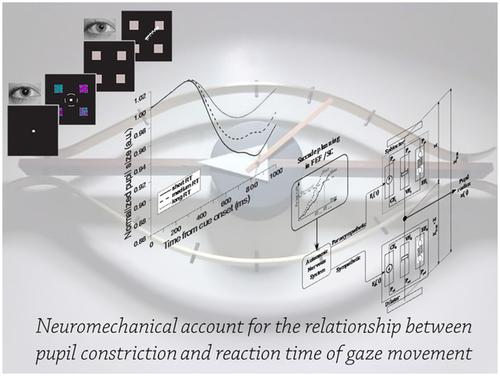当前位置:
X-MOL 学术
›
Eur. J. Nerosci.
›
论文详情
Our official English website, www.x-mol.net, welcomes your feedback! (Note: you will need to create a separate account there.)
Pupil dynamics: A potential proxy of neural preparation for goal-directed eye movement
European Journal of Neroscience ( IF 3.4 ) Pub Date : 2021-09-12 , DOI: 10.1111/ejn.15453 Pragya Pandey 1 , Supriya Ray 1
European Journal of Neroscience ( IF 3.4 ) Pub Date : 2021-09-12 , DOI: 10.1111/ejn.15453 Pragya Pandey 1 , Supriya Ray 1
Affiliation

|
The pupils reflexively constrict or dilate to regulate the influx of light on the retinae. Pupillary light reflex (PLR) is susceptible to many non-visual cognitive processes including covert orientation of attention and planning rapid saccadic eye movement. The frontal eye field (FEF) and superior colliculus (SC), which also send projections to the PLR pathway, are two important areas in primate's brain for planning saccade and orientation of attention. The saccadic reaction time (SRT) and the rate of increase in activity of movement neurons in these areas are inversely correlated. This study addressed how pupil dynamics, activity in the FEF and SC and SRT are related in a saccadic decision-making task. The rate of visually evoked pupil constriction was found inversely related to SRT. This was further verified by simulating a homeomorphic biomechanical model of pupillary muscle plants, wherein we projected signals similar to build-up activity in the FEF and SC to the parasympathetic (constriction) and sympathetic (dilation) division of the PLR pathway, respectively. A striking similarity between simulated and observed dynamics of pupil constriction suggests that PLR is a potential proxy of saccade planning by movement neurons in the FEF and SC. Indistinguishable pupil dynamics when planned saccades were elicited versus when they were cancelled eliminated the possibility that the obligatory pre-saccadic shift of attention alone influenced the rate of pupil constriction. Our study envisages a mechanism of how the oculomotor system influences the autonomic activity in an attempt to timely minimize saccadic visual transients by regulating the influx of light.
中文翻译:

瞳孔动力学:目标导向眼球运动的神经准备的潜在代理
瞳孔反射性地收缩或扩张以调节光在视网膜上的流入。瞳孔光反射 (PLR) 易受许多非视觉认知过程的影响,包括注意力的隐蔽方向和计划快速扫视眼球运动。额叶眼场 (FEF) 和上丘 (SC) 也向 PLR 通路发送投影,是灵长类动物大脑中用于规划扫视和注意力方向的两个重要区域。这些区域的跳视反应时间 (SRT) 和运动神经元活动的增加率呈负相关。本研究探讨了 FEF 和 SC 以及 SRT 中的学生动态、活动如何在扫视决策任务中相关联。发现视觉诱发的瞳孔收缩率与 SRT 呈负相关。通过模拟瞳孔肌肉植物的同形生物力学模型进一步验证了这一点,其中我们将类似于 FEF 和 SC 中积聚活动的信号分别投射到 PLR 通路的副交感神经(收缩)和交感神经(扩张)分支。模拟和观察到的瞳孔收缩动力学之间惊人的相似性表明 PLR 是 FEF 和 SC 中运动神经元扫视规划的潜在代表。当计划的扫视被引出时与被取消时无法区分的瞳孔动态消除了单独的强制性前扫视转移影响瞳孔收缩率的可能性。
更新日期:2021-10-20
中文翻译:

瞳孔动力学:目标导向眼球运动的神经准备的潜在代理
瞳孔反射性地收缩或扩张以调节光在视网膜上的流入。瞳孔光反射 (PLR) 易受许多非视觉认知过程的影响,包括注意力的隐蔽方向和计划快速扫视眼球运动。额叶眼场 (FEF) 和上丘 (SC) 也向 PLR 通路发送投影,是灵长类动物大脑中用于规划扫视和注意力方向的两个重要区域。这些区域的跳视反应时间 (SRT) 和运动神经元活动的增加率呈负相关。本研究探讨了 FEF 和 SC 以及 SRT 中的学生动态、活动如何在扫视决策任务中相关联。发现视觉诱发的瞳孔收缩率与 SRT 呈负相关。通过模拟瞳孔肌肉植物的同形生物力学模型进一步验证了这一点,其中我们将类似于 FEF 和 SC 中积聚活动的信号分别投射到 PLR 通路的副交感神经(收缩)和交感神经(扩张)分支。模拟和观察到的瞳孔收缩动力学之间惊人的相似性表明 PLR 是 FEF 和 SC 中运动神经元扫视规划的潜在代表。当计划的扫视被引出时与被取消时无法区分的瞳孔动态消除了单独的强制性前扫视转移影响瞳孔收缩率的可能性。



























 京公网安备 11010802027423号
京公网安备 11010802027423号